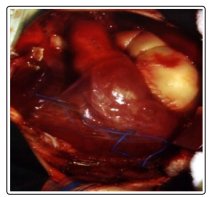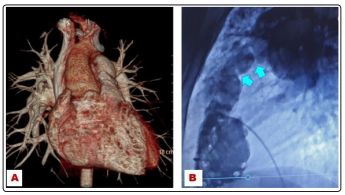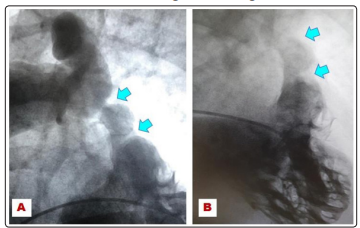Author(s): Lubna Alruwaili*, Sulaiman Al-Habib, Khalid Alnemer and Faisal Mohammed Alamro
Novel coronavirus-19 disease (COVID-19) is associated with significant cardiovascular morbidity and mortality. These two-case report suggest that transient sinus bradycardia is a possible manifestation of COVID-19 and an important for close surveillance [1]. These cases were presented with isolated symptomatic primary sinus bradycardia which was transient and disappear by the recovery of the COVID-19 infection.
Coronavirus disease 2019 (COVID-19) is defined as illness caused by a novel coronavirus now called severe acute respiratory syndrome coronavirus 2 (SARS-CoV-2; formerly called 2019-nCoV), which was first identified amid an outbreak of respiratory illness cases in Wuhan City, Hubei Province, China. While COVID-19 primarily affects the lungs, causing interstitial pneumonitis and severe acute respiratory distress syndrome (ARDS), it also affects multiple organs, particularly the cardiovascular system. The cardiovascular system appears to have complex interactions with COVID-19, including, chest pain, fulminant heart failure, cardiac arrhythmias, and cardiac death. Indeed, symptoms of cardiac chest pain and palpitations are the presenting features in some patients [2].
Patient A is a 48-year-old gentleman, previously healthy. Who was confirmed as a COVID-19 case by a nasopharyngeal swab done in 29/5/2020. He presented initially to emergency department (ER) with a complain of shortness of breath, cough with haemoptysis and bilateral lower limb muscle pain with subjective weakness, upon arrival to (ER) His pulse oxygen saturation was 98% on Room air, temperature was 36.5 °C, haemodynamically stable 125/76 mmHg, heart rate of 60 bpm, with initial work up sent.
During hospital stay the patient received ceftriaxone and azithromycin for 5 days with the last dose given in 4/6/2020 and started on 2 L Nasal Cannula to keep Oxygen saturation above 92%. However, in 3/6/2020 the he spiked fever of 38°C, associated with multiple episodes of watery diarrhea and abdominal cramps, Cultures of blood, urine and sputum were sent as well as Clostridium difficile toxins sample, in which were all came back negative. Electrolyte panel was with in normal. The intravenous cannula site was not infected. Furthermore, the patient developed Bradycardia with a heart rate of 48 Bpm in 5/6/2020. ECG was done and showed sinus bradycardia (Figure 1) clinically the patient became more tachypnoeic and distressed with multiple episodes of dizziness along with generalized fatigue and lethargy. He denied any chest pain, palpitation or syncope.

Figure 1: Electrocardiogram showing Sinus brady cardia
Inflammatory markers were reordered, with significant trending up from admission. Other investigation showed: Thyroid Stimulating Hormone level was (1.422), Troponin I (<0.010), the patient was started on Methylprednisolone in 6th of June as well as valsartan. Echocardiogram was done and reported normal with Ejection fraction of (61). Chest x ray was repeated in 6th of June for correlation with his deterioration, which showed significant increase in infiltration, in compare with the initial chest X ray done in 29 of May (Figure 2).

Figure 2: Chest x ray showing significant increase in Lung infiltration from initial presentation
Nonetheless the patient continued to have bradycardia with multiple spikes of fever with high blood pressure (Table 1) despite medical management. Treatment with temporary pacemaker was considered however, the patient was opposed to it, thereby he was treated conservatively, in which spontaneous remission was achieved. Patient B was a 29-year-old male, diabetic, presented to the emergency department with a complain of cough, loss of appetite for 3 days and generalizes malaise, who was a confirmed case as a COVID-19, by a nasopharyngeal swab done in 17/06/2020.
| Date | June 3 | June 4 | June 5 | June 6 | June 8 | June 10 |
|---|---|---|---|---|---|---|
| Pulse (Bpm) | 95 | 92 | 48 | 47 | 51 | 78 |
| Blood pressure |
133/64 | 120/85 | 154/70 | 169/85 | 182/95 | 110/78 |
| Temperature | 37.8 | 38 | 36.8 | 38 | 36.6 | 36.8 |
| Spo2 (%) | 95% | 95% | 96% | 94% | 95% | 96% |
The vitals recorded in the emergency department in 18/06/2020, were documented as the following: temperature of 36.80 °C, 39 beat per minute for the heart rate, with BP of 210/90 mmHg, spo2 of 94% on 7 Liter facial mask. During hospital stay the patient developed bradycardia with a heart rate of rate of 39 to 45, however the patent denied any symptoms, including chest pain, headache, palpitation. Moreover, his blood pressure in both arms was persistently high with a range of 210/90 to 190/90, in which for he was started on amlodipine, serial troponin I and ECG were done, with basic labs were sent.
His ECG showed sinus bradycardia, (Figure 3). The serial troponin I resulted <0.010ηg/ml, which implies as a negative. Pro-BNP was 768, LDH; 452 U/I, CRP; 56, D.dimer; 0.62, ferritin; 799 ηg/ml, and Magenesium; 0.88, his TSH level was: 0.367 mIU/L, with normal electrolyte panel.

The patient was started on azithromycin and ceftriaxone in June 19, for the bilateral lung consolidation showed in chest x-ray, As well as Dexamethasone, for high inflammatory markers. In spite of that, our patient remained bradycardic until 27 of June (Table 2). The patient was treated conservatively, consequently, patient’s symptoms, along with his bradycardia had improved, until all had resolved, and the patient was back to his usual state of health.
| Date | June 19 | June 19 | June 22 | June 24 | June 26 | June 28 | June 29 |
|---|---|---|---|---|---|---|---|
| Pulse (Bpm) | 39 | 58 | 44 | 49 | 48 | 65 | 65 |
| Blood pressure |
210/90 | 132/65 | 190/74 | 162/80 | 140/68 | 144/74 | 145/64 |
| Temperature | 36.8 | 36.2 | 36.7 | 36.4 | 36.9 | 36.5 | 36.4 |
| Spo2 (%) | 92% | 96% | 93% | 94% | 94% | 95% | 95% |
The potential mechanisms for sinus bradycardia in patients with COVID-19 include myocardial inflammation or direct viral infiltration. Patients diagnosed with COVID-19 should be monitored closely for the development of bradyarrhythmia and hemodynamic instability [3, 4].
Our patients were previously healthy with no previous diagnosed cardiovascular disease, who were admitted in general medical floor, with stable vitals initially, which did not require any oxygen support or inotropes, as seen in our patients. With onset of persistent bradycardia, which was managed by conservative management only, in which our patients showed dramatical improvement, along with the recovery from COVID-19 infection. With every other cause of bradycardia was ruled out, including normal echo cardiogram, Normal electrolyte panel. Moreover, clear correlation between the onset of bradycardia and the medication could not be found. The clinical characteristics of Major myocarditis and myocardial infarction were not presented among these patients, suggesting these are not the cause of sinus bradycardia in this patient. The thyroid function of this patient was normal, ruling it out as a secondary cause.
While limited data exist on the numbers of the patient who developed sinus bradycardia from COVID-19 infection, and the mechanisms of bradycardia from COVID-19 have not been fully elucidated. Direct myocardial cells injury: can be due to acute cardiac injury from different etiologies such as hypoxia-mediated, worsening of coronary perfusion, direct tissue damage, a product of hyperacute systemic inflammatory response syndrome or it could be due to the effects of medications used in the management of COVID-19 [5-7].
Nevertheless, there is evidence that infection of secretory cell population in the bronchial branches is influenced not only by ACE2 expression, but also by the proteases TMPRSS2 and Furin as potential cofactors. So far, it is not known what role these proteases play in the binding, uptake and replication of SARS-Cov-2 in the heart cells and thus in mediating cardiac damage. Cytokine release syndrome (aka ‘cytokine storm’), a poorly understood immunopathological process caused by hyper induction of proinflammatory cytokines such as interleukin (IL)-1, IL-6, T helper 1 cytokine interferon-gamma, and tumor necrosis factor-alpha (TNF-α), has been reported in the setting of SARS, MERS, and influenza [8-16]. It is postulated that proinflammatory cytokines depress myocardial function immediately throughactivation of the neural sphingomyelinase pathway and sub acutely (hours to days) via nitric oxide-mediated blunting of beta-adrenergic signaling. It may be that the high levels of pro-inflammatory cytokines, including IL-6 directly act on the sinoatrial (SA) node [6]. The clinical and biochemical profiles of these patients with highly elevated ferritin suggest cytokine release contribution. To our knowledge this is the first case report illustrate temporary sinus bradycardia as a cardiac manifestation in COVID-19 patients.
COVID-19 may be associated with clinically significant Sinus node dysfunction. Even in patient without pre-existing cardiovascular disease. Patients diagnosed with COVID-19 should be monitored closely for the development of bradyarrhythmia, which might have a significant impact upon their long-term outcome. Potential mechanisms for bradyarrhythmia is still obscured, more research is needed to comprehend the possible mechanism. Nonetheless multi-disciplinary management of such cases and close clinical follow-up are therefore essential.
